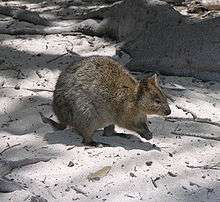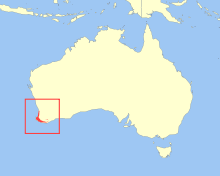Quokka
| Quokka | |
|---|---|
 | |
| Scientific classification | |
| Kingdom: | Animalia |
| Phylum: | Chordata |
| Class: | Mammalia |
| Infraclass: | Marsupialia |
| Order: | Diprotodontia |
| Family: | Macropodidae |
| Subfamily: | Macropodinae |
| Genus: | Setonix Lesson, 1842 |
| Species: | S. brachyurus |
| Binomial name | |
| Setonix brachyurus (Quoy & Gaimard, 1830) | |
 | |
| Geographic range | |
The quokka (/ˈkwɒkə/, Setonix brachyurus), the only member of the genus Setonix, is a small macropod about the size of a domestic cat.[2] Like other marsupials in the macropod family (such as kangaroos and wallabies), the quokka is herbivorous and mainly nocturnal. Quokkas can be found on some smaller islands off the coast of Western Australia, in particular on Rottnest Island just off Perth and Bald Island near Albany. A small mainland colony exists in the protected area of Two Peoples Bay Nature Reserve, where they co-exist with Gilbert's potoroo.
Traits
The quokka weighs 2.5 to 5 kilograms (5.5 to 11.0 lb) and is 40 to 54 centimetres (16 to 21 in) long with a 25 to 30 centimetres (9.8 to 11.8 in) long tail, which is fairly short for a macropod. It has a stocky build, rounded ears, and a short, broad head. Although looking rather like a very small kangaroo, it can climb small trees and shrubs. Its coarse fur is a grizzled brown colour, fading to buff underneath.
The quokka has little fear of humans and it is common for it to approach them closely, particularly on Rottnest Island. It is, however, illegal for members of the public to handle the animals in any way on Rottnest Island. An infringement notice carrying a A$300 fine can be issued by the Rottnest Island Authority for such behaviour.[3] In addition, prosecution of the offense can result in a fine of up to $2,000.[4][5]
Discovery by Europeans


The quokka was one of the first Australian mammals seen by Europeans. The Dutch mariner Samuel Volckertzoon wrote of sighting "a wild cat" on Rottnest Island in 1658. In 1696, Willem de Vlamingh mistook them for giant rats and named the island "Rotte nest", which comes from the Dutch word rattennest meaning "rat nest".
The word quokka is derived from a Nyungar word, which was probably gwaga.[6]
Ecology
In the wild, its roaming is restricted to a very small range in the South-West of Western Australia, with a number of small scattered populations. There is one large population on Rottnest Island and a smaller population on Bald Island near Albany.[7] The islands are free of foxes and cats. On Rottnest, quokkas are common and occupy a variety of habitats ranging from semi-arid scrub to cultivated gardens.[8]
Diet
Like most macropods, quokkas eat many types of vegetation, including grasses and leaves. A study found that flowering plants of the genus Guichenotia are one of the quokka's favourite foods.[9]
Population
Although numerous on the small offshore islands, the quokka has a very restricted range and is classified as vulnerable.[7] On the mainland, where it is threatened by most introduced predatory species such as foxes, it requires dense ground cover for refuge. Clearfell logging and agricultural development have reduced this habitat, thus contributing to the decline of the species. The introduction of cats and dogs, as well as dingoes, has added to the problem, as has the clearing and burning of the remaining swamplands. Moreover, quokkas usually have a litter size of one and successfully rear one young each year. Although these animals are constantly mating, usually one day after their young is born, the small litter size paired with the restricted space and threatening predators contribute to the scarcity of these marsupials on the mainland.[10]
References
- ↑ de Tores, P., Burbidge, A., Morris, K. & Friend, T. (2008). Setonix brachyurus. In: IUCN 2008. IUCN Red List of Threatened Species. Retrieved 29 December 2008.
- ↑ Groves, C.P. (2005). Wilson, D.E.; Reeder, D.M., eds. Mammal Species of the World: A Taxonomic and Geographic Reference (3rd ed.). Baltimore: Johns Hopkins University Press. p. 69. OCLC 62265494. ISBN 0-801-88221-4.
- ↑ Rottnest Island Regulations 1988 (WA), rr 40 & 73; sched. 4
- ↑ Rottnest Island Regulations 2007 (WA), r 40
- ↑ "Rare marsupials kicked to death in 'quokka soccer'", The Daily Telegraph, 2003
- ↑ Dixon, R. M. W.; Moore, Bruce; Ramson, W. S.; Thomas, Mandy (2006). Australian Aboriginal Words in English: Their Origin and Meaning (2nd ed.). Oxford: Oxford University Press. ISBN 0-19-554073-5.
- 1 2 Roger Underwood, Doomed Planet: On the origin of the specious, Quadrant, August 31, 2012
- ↑ "A close encounter of the furry kind". Australian Geographic. 2010. Retrieved 2010-04-22.
- ↑ "Quokkas' favourite foods and shelter identified in Rottnest Island study". ABC News.
- ↑ Nocon, Wojtek. "Sentonix Brachyurus". Quokka. University of Michigan. Retrieved 30 September 2013.
External links
| Wikimedia Commons has media related to Quokka. |
| Wikispecies has information related to: Setonix brachyurus |
| Look up quokka in Wiktionary, the free dictionary. |
